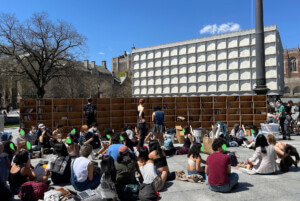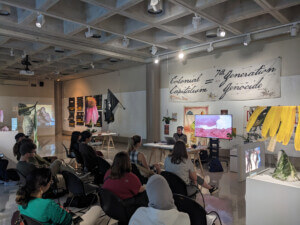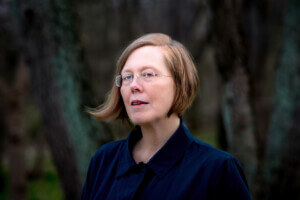It’s the start of the 2023–24 academic year, so that means a new crop of leaders are beginning the semester. To check in, AN spoke with a set of leading educators about their roles. Each answered a septet of questions; the second in this series is Daniel Barber, Head of School, Architecture at the University of Technology Sydney.
What are your goals and ambitions for your new role?
I am the Head of School, Architecture at the University of Technology Sydney. The School includes Architecture, Landscape Architecture, and Interiors. We have begun to frame three major focus areas of research, teaching, and public discourse. These are (1) Decarbonization and biodiversity; (2) Designing with country and valuing Indigenous knowledge; and (3) Equity and housing affordability. These are all interconnected. They are also obvious, and we are approaching them by asking the question: “What else would an architecture school do?”
I recognize that these three issues frame searing, existential questions for our field. Yet in the academy, we have the unique opportunity to experiment, test, consider, reflect on and engage with these issues. My goal is to find ways to both train our students as leaders and also to work with the profession and industry at large to move these issues into the public realm. So, I see this as a moment of the schools being on the leading edge, helping the profession engage these challenges.
This is about a changing social role for architecture and working through specifics of pedagogy, research, and public discussion needed to stay on top of the larger socio-ecological transformation in progress.
I am also focused on how we operate as an institution. Insisting on an equitable workplace and transparent decision-making, and developing processes and frameworks that allow for consultation and engagement not only with our faculty, but also adjuncts and professional staff. With the support of a labor union, we are working to convert a number of casual positions to full-time roles. We aim to model this ethical approach for our students, and provide the tools for them to encourage transparency and equity in the professional world.
Who is someone who has inspired your work and leadership? Why are they inspirational?
I would say first of all I am inspired by my colleagues and students. The opportunity to amplify their work and bring it into the world, and to nurture the brilliance of our students is what motivates me every day. We are very much a horizontal organization, inspiring each other. In terms of mentors, Peggy Deamer was my MED advisor at Yale and a model for engaged leadership. In particular, I have tried to emulate her willingness to take a stand and reach towards a higher objective, amidst all the details that can overwhelm university work.
One of the formative moments of my training, such as it is, in organizational management, was my time in the 90s as a member of the Left Bank Books Collective in Seattle, which kept me focused on the value of consensus and consultation. There, I nurtured an awareness that democracy is messy, cumbersome, and time consuming, but always worth the effort.
What are the most urgent topics and challenges for architectural education today?
Decarbonization, decolonization, and equity. Our fields are being challenged to transform radically. A more efficient building is not enough—we need to look at sufficiency principles as we consider our interventions in the built environment. Indigenous knowledge and the imperative for reparations resonates strongly across built environment fields. Modes of production and representation in architecture, as much as the buildings produced, have often been a medium of colonization and oppression. We need to be thoughtful of and focused on how to insist on other values. We need to think, draw, and conceive of architecture in radically new ways. And the housing affordability crisis is epochal, and very much on the minds of the students we are training.
As we face the challenge of cultivating expertise in these new social roles for architecture, we must develop methods that serve those in need, rather than those in power. Of course, not only in what we teach but how we challenge colonial models of knowledge production in our courses and studios. This is how to train our students to insist on an ethical workplace. It is a whole new world.
How should the topic of sustainability be incorporated into architectural education?
It is not a question of incorporation so much as a re-definition of the social role of the architect. Again, the three pillars we are focusing on, the interconnections between decarbonization, decolonization, and equity, with further ramifications for biodiversity, community engagement, and policy, among other concerns. “Sustainability” hasn’t worked: it’s functioning as a permission structure for business as usual. Sustainability is an attempt to maintain existing systems, with a slight inflection in efficiency. We see a need to more fully reconsider the project of architecture and the value of interventions in the built world. Today, all buildings must aim to end carbon profligacy and to encourage new kinds of social collectivity. The polycrisis is happening now.
How should the goals of diversity and inclusivity be advanced under your leadership?
In Australia, this issue has many dimensions. Some are familiar to the U.S. context, in terms of generally diversifying faculty and student bodies; others involve cultural and industry-wide imperatives to engage Indigenous knowledge and values that exceed the discussion elsewhere. For example, to get building permits here often requires a statement of engagement with local Indigenous communities; the traditional custodians of the land on which the project is being built.
At the same time, as with DEI in the U.S., the systems in place are subject to manipulation in insincere engagement—they don’t solve the problem so much as call it out, reveal its changing contours. Just because a principle or regulation exists does not mean it is changing the culture. We are eagerly engaging with our Indigenous colleagues and partners, aiming to bring them into the core of our curriculum revisions and research support structures. We are working to hire more Indigenous staff and to focus our courses and public programs on cultivating connections to Country while also aiming to amplify these perspectives and support our colleagues in national and global discussions on decolonization.
We are also sharply focused on addressing gender imbalance in the academy, in terms of representation but also in terms of leadership, as more generally honing pathways for success – in academia and the profession – for a more diverse body. One of my first acts as Head of School was to sign up as an institutional sponsor for Parlour, an amazing advocacy group in Australia that is focused on addressing gender and other inequities. As with “sustainability,” this is not a sub-category of involvement but a chance to reconsider what it means to train professionals, what it means to intervene in the public realm, with a host of conceptual, material, and process issues that we are eager to cultivate.
What are you optimistic about as you create the future of architecture and architectural education?
For decades or longer, there has been heightened discussion about the agency of the architect—a fraught topic at the root of much frustration in architecture schools. Can architects change the world? Our approach is pragmatic (the world is changing already, daily and dramatically). Our scope, however, is to consider how, where, and when we can be most effectively involved. Put another way, while architects are not in charge of the socio-ecological transformations in process, it can’t happen without us. So how can we train our students and educate ourselves on the practical skills and critical attitudes most appropriate to these new challenges? We are all upskilling, conceptually and practically, to meet these challenges. The architecture school of today is unrecognizable to the one that my colleagues and I were trained in, in five years I expect it will be unrecognizable again. Our ambition is to lead this process of professional transformation, provide avenues to catalyze change, and work together with partners to build a more equitable world, to put it optimistically.











